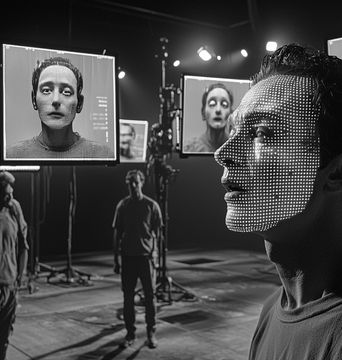AI-POWERED FILM: HANKS, WRIGHT PORTRAYED IN 60-YEAR SPAN BY CUTTING-EDGE FACIAL TRANSFORMATION TECH!

TriStar Pictures has raised the standard in the realm of filmmaking with the release of its film "Here," directed by famed American filmmaker, Robert Zemeckis. Leveraging real-time generative AI face transformation technology, the film represents an incredible utilization of AI in portraying actors across varying time periods.
The groundbreaking de-aging technology, developed by visual effects company Metaphysic, allows for the reinterpretation of the actors’ appearances in real-time. This revolutionary film adaptation of a 2014 graphic novel features actors Tom Hanks and Robin Wright, whose age transformations throughout the film were carried out entirely with AI, and not by casting different actors embodying various age spectrums.
This emergent technology operates by training machine learning models using frames from Hanks' and Wright's previous films. The technology then processes their facial landmarks and maps them to specific trained age variations, effectively generating flawless age transitions all in real-time.
The development signifies a remarkable leap in the field of cinematography that traditionally employs manual work spanning months, in addition to considerable costs associated with post-production CGI to deliver age-based actor transformations. Metaphysic's facial modification system negates the need for both element, forever changing the trajectory of film production.
This technological triumph and its unusual and insightful utilization are reaffirmed by Zemeckis' own words. He candidly admitted that the film would not have been viable three years ago, attributing the arduous manual work, ballooning costs, and the sheer number of artists essential for this caliber of face modification as significant impediments.
What sets Metaphysic's generative AI technology apart from the previous AI-related attempts at de-aging actors, however, is its capacity to execute the transformations without relying on any additional hardware. What's more, it can display the results instantly during the filming process itself. This is a revolutionary deviation from the normative processes that demand a rigorous post-production phase.
The implications of this development are far-reaching as it implies an irreversible shift in the filmmaking industry. Facets such as reduced costs, seamless filming process, and most strikingly effortless actor transformations imply a future of cinema that is not only more flexible but creatively limitless as well. With such technology already a reality, the film industry is set to augment the imagination and redefine the spectacle that is motion pictures.
One can also expect the reverberations of such an advancement to be felt in related genres – think advertising, theatre, or even video games. The future of age transformation in real-time attributes to not only the evolution of filmmaking but the evolution of story-telling itself. It opens new avenues for narratives, creating stories that are not just inventive but absolutely untrammelled by the limitations of time.